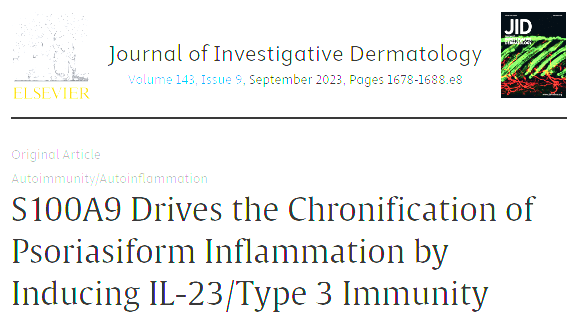S100A9 Drives the Chronification of Psoriasiform Inflammation by Inducing IL-23/Type 3 Immunity
Psoriasis is a chronic inflammatory skin disorder driven by the IL-23/type 3 immune response. However, molecular mechanisms sustaining the chronicity of inflammation and psoriatic lesions remain elusive. Combining systematic analyses of several transcriptomic datasets, we delineated gene signatures across human psoriatic skin, identifying S100A9 as one of the most up-regulated genes, which was confirmed in lesioned skin from patients with psoriasis and preclinical psoriasiform skin inflammation models. Genetic ablation or pharmacologic inhibition of S100A9 alleviated Aldara-induced skin inflammation. By single-cell mapping of human psoriatic skin and bone marrow chimeric mice experiments, we identified keratinocytes as the major source of S100A9. Mechanistically, S100A9 induced IL-23 production by dendritic cells, driving the IL-23/type 3 immunity in psoriasiform skin inflammation. In addition, the cutaneous IL-23/IL-17 axis induced epidermal S100A9 expression in human and experimental psoriasis. Thus, we showed an autoregulatory circuit between keratinocyte-derived S100A9 and IL-23/type 3 immunity during psoriasiform inflammation, identifying a crucial function of S100A9 in the chronification of psoriasis
Authors
Silva de Melo BM, Veras FP, Zwicky P, et al.
External link
Publication Year
Publication Journal
Associeted Project
Microbiology or Immunology
Lista de serviços
-
StructRNAfinder: an automated pipeline and web server for RNA families prediction.StructRNAfinder: an automated pipeline and web server for RNA families prediction.
-
CEMiTool: a Bioconductor package for performing comprehensive modular co-expression analyses.CEMiTool: a Bioconductor package for performing comprehensive modular co-expression analyses.
-
webCEMiTool: Co-expression Modular Analysis Made Easy.webCEMiTool: Co-expression Modular Analysis Made Easy.
-
Assessing the Impact of Sample Heterogeneity on Transcriptome Analysis of Human Diseases Using MDP Webtool.Assessing the Impact of Sample Heterogeneity on Transcriptome Analysis of Human Diseases Using MDP Webtool.
-
Predicting RNA Families in Nucleotide Sequences Using StructRNAfinder.Predicting RNA Families in Nucleotide Sequences Using StructRNAfinder.
-
OUTBREAK: a user-friendly georeferencing online tool for disease surveillance.OUTBREAK: a user-friendly georeferencing online tool for disease surveillance.
-
Noninvasive prenatal paternity determination using microhaplotypes: a pilot study.Noninvasive prenatal paternity determination using microhaplotypes: a pilot study.
-
Editorial: User-Friendly Tools Applied to Genetics or Systems Biology.Editorial: User-Friendly Tools Applied to Genetics or Systems Biology.
-
Automatic detection of the parasite Trypanosoma cruzi in blood smears using a machine learning approach applied to mobile phone imagesAutomatic detection of the parasite Trypanosoma cruzi in blood smears using a machine learning approach applied to mobile phone images
-
Tucuxi-BLAST: Enabling fast and accurate record linkage of large-scale health-related administrative databases through a DNA-encoded approachTucuxi-BLAST: Enabling fast and accurate record linkage of large-scale health-related administrative databases through a DNA-encoded approach
-
Ten quick tips for harnessing the power of ChatGPT in computational biologyTen quick tips for harnessing the power of ChatGPT in computational biology

